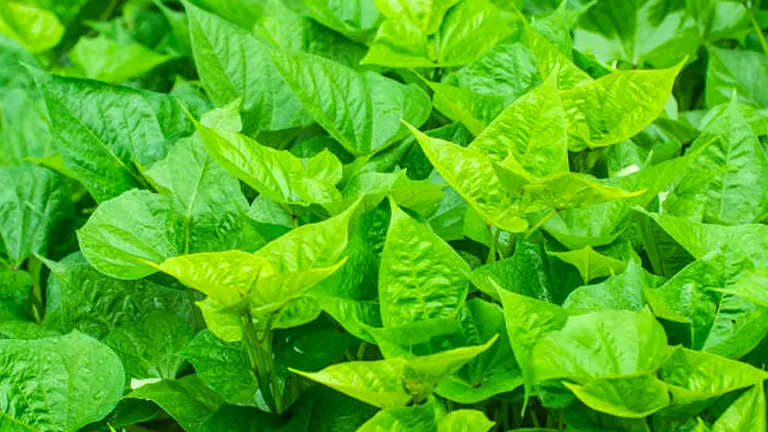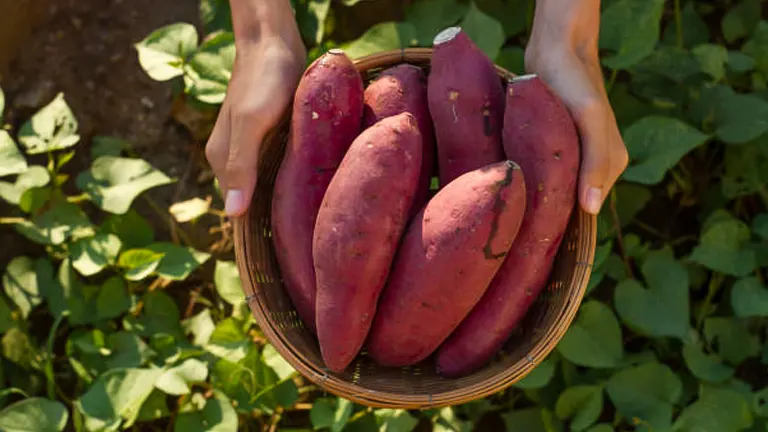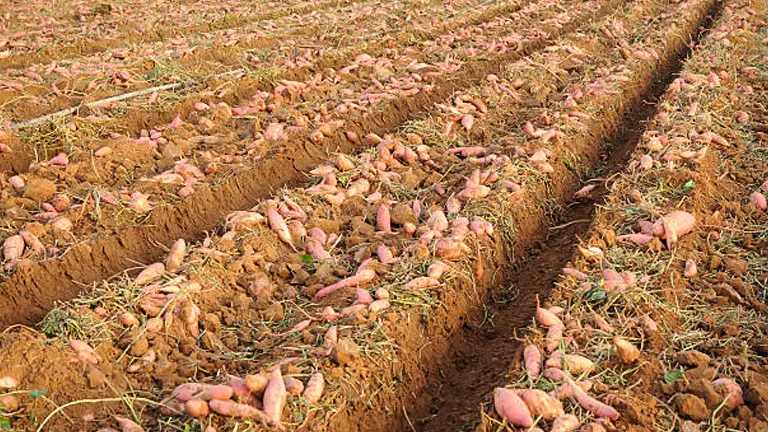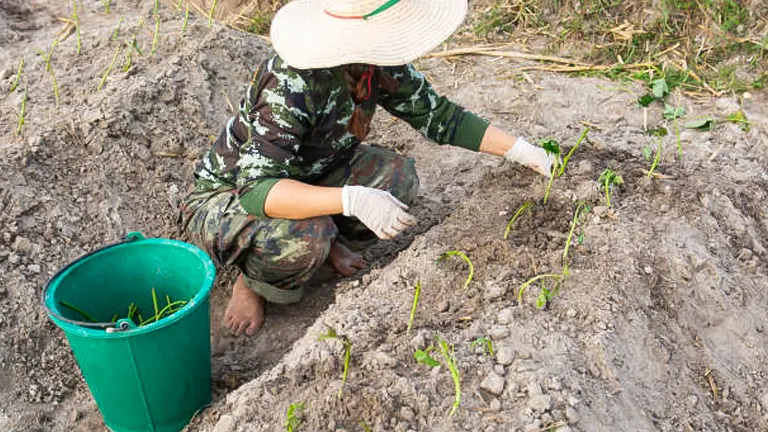How to Grow and Care for Sweet Potatoes: Achieve Incredible Growth with These Tips
- May 17, 2024
- 0 comment
Learn how to grow and care for sweet potatoes with our expert tips. Achieve incredible growth and a bountiful harvest with these proven methods. Sweet potatoes are a delicious and nutritious addition to any garden, offering a rewarding experience for both novice and experienced gardeners. Growing and caring for sweet potatoes may seem challenging, but with the right knowledge and techniques, you can achieve incredible growth and enjoy a bountiful harvest.

In this guide, we’ll walk you through the essential steps and expert tips to ensure your sweet potato plants thrive, from planting to harvesting. Whether you’re looking to enhance your garden’s productivity or simply enjoy the satisfaction of homegrown sweet potatoes, these tips will set you on the path to success.
Table of Contents
- What are Sweet Potatoes?
- Selecting the Right Variety
- Preparing the Soil
- Planting Techniques
- Ongoing Care and Maintenance
- Pruning and Training Techniques
- Troubleshooting Common Issues
- Conclusion
- FAQs
What are Sweet Potatoes?

Sweet potatoes, scientifically known as Ipomoea batatas, are not only a staple food in many parts of the world but also a highly nutritious root vegetable that can add variety to any diet. Unlike common potatoes, which are tubers, sweet potatoes are considered roots and belong to the morning glory family (Convolvulaceae).
Physical Characteristics and Nutritional Profile
Sweet potatoes have distinctive physical characteristics. They feature smooth skins that vary in color from white and yellow to red and deep purple. Their flesh ranges from white and orange to vibrant purple, each offering different flavors and nutritional profiles. For example:
- Orange-fleshed sweet potatoes are rich in beta-carotene, a precursor to vitamin A. One medium-sized orange sweet potato (130 grams) contains about 1,096 micrograms of vitamin A, providing more than 100% of the daily recommended intake.
- Purple-fleshed varieties contain anthocyanins, powerful antioxidants that have been linked to reduced inflammation and improved eye health.
Nutritional Content of Different Sweet Potato Varieties
| Nutrient (per 100g) | Orange-Fleshed Sweet Potato | Purple-Fleshed Sweet Potato | White-Fleshed Sweet Potato |
|---|---|---|---|
| Calories | 86 | 90 | 77 |
| Carbohydrates (g) | 20.1 | 21.0 | 17.5 |
| Dietary Fiber (g) | 3.0 | 3.2 | 2.8 |
| Sugars (g) | 4.2 | 4.5 | 3.8 |
| Vitamin A (μg) | 709 | 14 | 0 |
| Vitamin C (mg) | 2.4 | 3.1 | 2.7 |
| Anthocyanins (mg) | 0 | 150 | 0 |
| Beta-Carotene (μg) | 8,509 | 0 | 0 |
Adaptability and Growth Conditions
Sweet potatoes are renowned for their adaptability to a wide range of soil types and climates. They thrive in warmer climates where the soil temperature is consistently above 65°F (18°C), making them ideal for diverse agricultural practices. The plant is a vigorous grower, spreading trailing vines that can cover the ground, shading out competing weeds and protecting the soil from erosion.
Historical and Cultural Significance
The history of sweet potatoes traces back to Central and South America, where they have been cultivated for thousands of years. Archaeological evidence suggests that sweet potatoes were domesticated around 8,000 years ago. Today, they are grown worldwide and have become integral to various cuisines due to their versatility. Sweet potatoes can be baked, steamed, roasted, or mashed, making them a popular choice for both savory dishes and desserts.
Unique Information and Scientific Insights
- Genetic Diversity: Sweet potatoes have a high level of genetic diversity, which allows them to adapt to different environmental conditions. This diversity is crucial for breeding programs aimed at improving disease resistance and yield.
- Nutritional Benefits: Besides being rich in vitamins, sweet potatoes provide complex carbohydrates and dietary fiber, which are beneficial for maintaining stable blood sugar levels and supporting digestive health.
- Research on Health Benefits: Studies have shown that sweet potatoes have anti-carcinogenic properties due to their high levels of antioxidants. For example, a study published in the Journal of Food Science found that the anthocyanins in purple sweet potatoes inhibited the growth of certain cancer cells in vitro.
Selecting the Right Variety

Choosing the right variety of sweet potato can significantly influence your gardening success and the quality of your harvest. Sweet potato varieties differ widely in color, texture, flavor, and growth characteristics, which are crucial factors to consider when planning your garden. Here’s a more detailed look at some of the key factors and unique information to help you select the best variety for your needs.
Key Factors in Selecting Sweet Potato Varieties
- Climate Adaptability:
- Different varieties have varying degrees of tolerance to climate conditions. For instance, ‘Beauregard’ thrives in warm, humid climates, making it ideal for southern regions, while ‘Covington’ performs well in a variety of conditions, including cooler climates.
- Sweet potatoes generally require a soil temperature of at least 65°F (18°C) to grow effectively. Varieties such as ‘Centennial’ can tolerate slightly cooler temperatures, making them suitable for regions with shorter growing seasons.
- Resistance to Pests and Diseases:
- Some varieties are bred specifically for resistance to common pests and diseases. For example, ‘Hernandez’ has good resistance to root knot nematodes, while ‘Murasaki’ is known for its resistance to Fusarium wilt.
- Choosing resistant varieties can reduce the need for chemical treatments and promote healthier growth, especially in organic gardening systems.
- Maturity Period:
- The time it takes for sweet potatoes to mature varies by variety. Early-maturing varieties like ‘Georgia Jet’ can be ready to harvest in as little as 90 days, making them ideal for regions with shorter growing seasons.
- In contrast, varieties like ‘Jewel’ require a longer growing period (up to 120 days), which is suitable for regions with longer, warmer seasons.
- Nutritional Content:
- Different varieties offer unique nutritional profiles. For instance, orange-fleshed varieties are high in beta-carotene, while purple-fleshed varieties are rich in anthocyanins.
- Nutritional diversity can cater to different dietary needs and preferences.
Unique Varieties and Their Characteristics
- ‘Beauregard’: Known for its deep orange flesh and high yield, this variety is highly adaptable and has a relatively short maturity period of around 90-100 days. It’s also resistant to Fusarium wilt and southern root knot nematode.
- ‘Japanese White’ (Satsuma-imo): This variety has a purple skin with white flesh, offering a unique sweet flavor. It is well-suited to cooler climates and typically matures in 100-120 days.
- ‘Covington’: A popular choice due to its consistent shape and size, ‘Covington’ has orange flesh and matures in approximately 110-120 days. It is also resistant to soil rot and internal cork.
- ‘Purple Majesty’: This variety features purple skin and flesh, rich in anthocyanins, which are powerful antioxidants. It matures in about 120 days and offers unique health benefits.
Comparison of Selected Sweet Potato Varieties
| Variety | Skin Color | Flesh Color | Maturity Period (days) | Climate Adaptability | Pest/Disease Resistance | Unique Nutritional Benefits |
|---|---|---|---|---|---|---|
| Beauregard | Orange | Deep Orange | 90-100 | Warm, Humid | Fusarium Wilt, Root Knot Nematode | High Beta-Carotene (8,509 μg per 100g) |
| Japanese White | Purple | White | 100-120 | Cooler, Temperate | General Disease Resistance | High Fiber, Lower Calories |
| Covington | Rose | Orange | 110-120 | Versatile | Soil Rot, Internal Cork | Consistent Shape, High Yield |
| Purple Majesty | Purple | Purple | 120 | Warm, Humid | General Disease Resistance | High Anthocyanins (150 mg per 100g), Antioxidant |
Tips for Selecting Varieties
- Consult Local Experts: Local agricultural extensions or reputable nurseries can provide slips (young plants) suited to your region, ensuring better growth outcomes. They can offer insights into the best varieties for your specific climate and soil conditions.
- Consider Your Growing Season: Match the maturity period of the variety with your growing season length to ensure the plants have enough time to develop fully.
- Experiment and Diversify: Plant multiple varieties to diversify your harvest and discover which types grow best in your garden conditions.
Preparing the Soil

Sweet potatoes thrive in well-drained, loamy soil with a slightly acidic pH of 5.5 to 6.5. Proper soil preparation is critical to prevent root diseases and encourage healthy growth. Here’s a comprehensive guide to preparing your planting area for sweet potatoes:
Soil Characteristics and Requirements
- Soil Type:
- Sweet potatoes prefer loamy soil, which is a balanced mixture of sand, silt, and clay. This type of soil provides optimal aeration, drainage, and nutrient retention.
- Sandy soils can be improved by adding organic matter to enhance water retention, while clayey soils can benefit from amendments to improve drainage and reduce compaction.
- pH Level:
- A slightly acidic pH of 5.5 to 6.5 is ideal for sweet potatoes. Soil pH influences nutrient availability; at this range, essential nutrients like phosphorus, potassium, and micronutrients are more accessible to the plants.
- Test your soil pH using a soil testing kit or send a sample to a local extension service. Adjust pH if necessary by adding lime to raise pH or sulfur to lower it.
Steps to Prepare the Planting Area
- Clear the Area:
- Remove all weeds, debris, and large stones from the soil to eliminate competition and improve aeration. Weeds can harbor pests and diseases, while stones can obstruct root growth.
- Amend the Soil:
- Incorporate compost or well-rotted manure to enhance soil fertility and structure. Sweet potatoes are heavy feeders, requiring nutrient-rich soil to develop large, healthy tubers.
- Organic matter improves soil structure, increases moisture retention, and promotes beneficial microbial activity. Aim for about 2-3 inches of organic matter mixed into the top 6-8 inches of soil.
- Ensure Good Drainage:
- Sweet potatoes cannot thrive in waterlogged conditions, which can lead to root rot and other fungal diseases. If your soil is heavy or clayey, consider raising the beds or incorporating sand and organic matter to improve drainage.
- Raised beds or ridges can help by allowing excess water to drain away from the roots, keeping the soil moisture levels optimal.
- Prepare the Garden Bed Early:
- Prepare your garden bed at least 2-3 weeks before planting. This allows the soil to settle and the organic amendments to integrate fully, creating a well-balanced environment for the young plants.
Additional Information and Scientific Insights
- Nutrient Management:
- Sweet potatoes require balanced nutrition for optimal growth. Key nutrients include nitrogen (N), phosphorus (P), and potassium (K). Excess nitrogen can lead to excessive vine growth at the expense of tuber development. A balanced fertilizer with a 1-2-2 NPK ratio is often recommended.
- Trace elements like boron and manganese are also important. Boron deficiency can lead to misshapen or cracked tubers. A soil test can help determine the need for micronutrient supplements.
- Soil Microbiology:
- Healthy soil is teeming with beneficial microbes that enhance nutrient availability and promote plant health. Adding organic matter supports microbial activity, creating a more resilient soil ecosystem.
- Mycorrhizal fungi, which form symbiotic relationships with sweet potato roots, can enhance nutrient and water uptake. Using mycorrhizal inoculants can be beneficial in soils with low fungal activity.
Ideal Soil Conditions for Sweet Potatoes
| Soil Property | Ideal Range/Condition | Importance | Amendments/Actions |
|---|---|---|---|
| Soil Type | Loamy | Provides optimal aeration, drainage, and nutrient retention | Add organic matter to sandy or clayey soils |
| pH Level | 5.5 – 6.5 | Ensures nutrient availability and healthy root development | Adjust with lime (raise pH) or sulfur (lower pH) |
| Organic Matter | 2-3 inches mixed into top 6-8 inches | Improves soil structure, moisture retention, and microbial activity | Incorporate compost or well-rotted manure |
| Drainage | Well-drained | Prevents root rot and other fungal diseases | Use raised beds, add sand and organic matter |
| Nutrient Content | Balanced NPK ratio (1-2-2) | Supports balanced growth and tuber development | Apply balanced fertilizer, conduct soil tests |
| Soil Microbiology | High microbial activity | Enhances nutrient cycling and plant health | Add organic matter, consider mycorrhizal inoculants |
Proper soil preparation is the foundation for a successful sweet potato harvest. By ensuring the soil meets the specific needs of sweet potatoes, you can prevent common issues and promote vigorous growth and high yields.
Planting Techniques

Planting sweet potatoes correctly is crucial for ensuring a bountiful harvest. The process begins with selecting healthy and vigorous slips, which are small sprouts that develop from a mature sweet potato. Here’s a comprehensive guide on how to plant them effectively:
Key Steps for Planting Sweet Potatoes
- Selecting Healthy Slips:
- Choose slips that are about 6-9 inches long with a healthy root system. Slips should be free from signs of disease or pests.
- It’s beneficial to use certified disease-free slips from reputable nurseries to minimize the risk of introducing pathogens to your garden.
- Timing:
- Plant sweet potato slips after the last frost when the soil has warmed to at least 65°F (18°C). This typically falls in late spring or early summer in most regions. Soil temperature is critical as sweet potatoes are sensitive to cold and thrive in warm conditions.
- Preparing Planting Holes:
- Dig small holes about 4 inches deep and place each slip so that the bottom half is buried in the soil. Burying the slips deeper can promote a more robust root system.
- Gently firm the earth around them to eliminate air pockets, which can cause the roots to dry out and impede plant establishment.
- Spacing:
- Medium-Density Planting: Space the slips 12-18 inches apart in rows that are 3 feet apart. This spacing allows adequate room for the vines to spread and ensures good air circulation, reducing the risk of fungal diseases.
- High-Density Planting: For more intensive cultivation, reduce the spacing to 9-12 inches between slips with 2-3 feet between rows. High-density planting can increase yield per area but requires careful management to prevent overcrowding and ensure each plant receives enough sunlight and nutrients.
Scientific Insights and Additional Information
- Root Development:
- Sweet potatoes develop from adventitious roots, which form along the buried portion of the slip. Providing sufficient space between plants ensures these roots have ample room to expand and form large tubers.
- Studies show that proper spacing can significantly impact yield. For instance, research indicates that closer spacing might increase the number of tubers but could reduce their size, whereas wider spacing tends to produce fewer but larger tubers.
- Soil Temperature:
- Soil temperature plays a critical role in sweet potato growth. Optimal soil temperature for root initiation and development ranges from 70°F to 85°F (21°C to 29°C). Below this range, growth is significantly slowed, and the risk of disease increases.
- Mulching:
- Applying mulch around the plants can help retain soil moisture, regulate soil temperature, and suppress weeds. Organic mulches like straw or grass clippings are effective and also contribute to soil fertility as they decompose.
- Water Management:
- Newly planted slips need consistent moisture to establish roots. Water the plants thoroughly after planting and maintain even soil moisture until the plants are well established. However, avoid waterlogging, as sweet potatoes are susceptible to root rot.
Optimal Planting Conditions for Sweet Potatoes
| Factor | Optimal Range/Condition | Importance | Recommendations |
|---|---|---|---|
| Soil Temperature | 65°F – 85°F (18°C – 29°C) | Ensures healthy root development and growth | Plant after last frost, use black plastic to warm soil |
| Planting Depth | 4 inches | Promotes robust root system | Bury slips halfway, firm soil around slips |
| Spacing (Medium) | 12-18 inches between plants, 3 feet rows | Prevents overcrowding, improves air circulation | Adjust based on growth habit and garden space |
| Spacing (High) | 9-12 inches between plants, 2-3 feet rows | Increases yield per area, requires careful management | Suitable for intensive farming |
| Mulching | Organic mulches (e.g., straw, grass) | Retains moisture, regulates temperature, suppresses weeds | Apply 2-3 inches around plants |
| Watering | Consistent, even moisture | Supports root establishment and growth | Water thoroughly after planting, avoid waterlogging |
Proper planting techniques are essential to the successful cultivation of sweet potatoes. By following these guidelines, you can create optimal growing conditions that promote healthy plant development and maximize your harvest.
Ongoing Care and Maintenance

Regular care is essential to grow healthy sweet potatoes. Here’s what you need to focus on:
- Watering: Sweet potatoes need consistent moisture, especially during the first few weeks post-planting and when tubers begin to form. Water the plants deeply once a week, allowing the soil to dry slightly between waterings.
- Fertilizing: About a month after planting, apply a balanced organic fertilizer to provide essential nutrients that support growth. Avoid high-nitrogen fertilizers, as they promote foliage rather than tuber development.
- Weed Control: Keep the planting area weed-free as weeds compete with sweet potatoes for nutrients. Mulching around the plants can help suppress weeds and maintain soil moisture.
Pruning and Training Techniques
Pruning sweet potato vines can enhance air circulation and focus the plant’s energy on tuber formation rather than vine growth:
- When to Prune: Begin pruning when vines start to spread too vigorously, typically a few weeks after planting.
- How to Prune: Trim back the vines to maintain a manageable size and prevent them from overshadowing other plants. Use clean, sharp scissors or shears to make cuts.
- Training Vines: If space is limited, consider training sweet potato vines on trellises or within contained spaces. This method can also facilitate easier harvesting and reduce the risk of pest infestations.
By following these detailed steps for planting, caring, and pruning, you can ensure that your sweet potato plants grow robustly and produce a plentiful harvest. The tips provided here combine traditional gardening techniques with practical insights to maximize your crop’s potential.
Troubleshooting Common Issues

Growing sweet potatoes can sometimes present challenges, but knowing how to identify and resolve common issues can greatly enhance your success:
- Yellowing Leaves: If the leaves of your sweet potato plants begin to yellow prematurely, this could be a sign of either nutrient deficiency or over-watering. Check the moisture level of the soil and consider applying a balanced fertilizer.
- Stunted Growth: Poor growth can often be attributed to compacted or nutrient-poor soil. Ensure that your soil is well-aerated and nutrient-rich. If pests are present, address them promptly as they can also hinder plant development.
- Soft Rot or Mold: These conditions are typically caused by too much moisture around the roots. Improve drainage in your planting beds and avoid over-watering to prevent these issues.
By monitoring your plants closely and adjusting care as needed, you can mitigate most problems and ensure healthy growth throughout the season.
Related Post
- How to Fertilize Bougainvillea: A Complete Guide for Stunning Blooms
- How to Fertilize Apple Trees: Essential Tips for a Bountiful Harvest
- How to Fertilize Lemon Trees: Secrets for Thriving Citrus
- How to Fertilize Avocado Tree: A Step-by-Step Guide for Lush Growth
Conclusion
Growing sweet potatoes is a rewarding endeavor that brings beauty to your garden and a nutritious, versatile crop to your table. This guide has covered everything from selecting the right variety, preparing the soil, planting, and care techniques, to managing pests and diseases, and finally, harvesting and storing your sweet potatoes. Each step is crucial and contributes to the overall success of your gardening efforts.
As you embark on your journey of growing sweet potatoes, remember that experimentation and patience are key. Each growing season offers new lessons and opportunities to refine your techniques. The efforts you put into cultivating these nutritious roots not only enhance your gardening skills but also contribute to a sustainable, healthy lifestyle.
FAQs
- Can sweet potatoes be grown from store-bought tubers?
While it’s possible to grow sweet potatoes from tubers purchased at a store, it’s not recommended due to potential disease and poor adaptation to your local climate. For best results, use certified disease-free slips from nurseries or agricultural extensions. - How can I improve sweet potato yields in a small garden space?
Optimize space by using vertical gardening techniques, such as trellising the vines. This approach not only saves space but can also reduce pest infestation and make harvesting easier. - What soil amendments are best for sandy soils when growing sweet potatoes?
In sandy soils, incorporate plenty of organic matter, such as compost or aged manure, to increase nutrient retention and improve moisture conservation, which are crucial for sweet potato growth. - How do I prevent sweet potatoes from becoming too fibrous?
Avoid over-fertilizing with nitrogen, which can lead to fibrous tubers. Also, ensure consistent watering as fluctuating moisture levels can also affect the texture of the sweet potatoes. - Can sweet potatoes be grown as a winter crop in warmer climates?
In regions with mild winters, such as USDA zones 9 and above, sweet potatoes can be planted in the autumn and grown through the winter, taking advantage of the cooler season to reduce pest problems. - What are some natural remedies for sweet potato scurf and black rot?
Rotate your sweet potato crops and avoid planting them in the same location more than once every three years. Clean up plant debris post-harvest and ensure good air circulation around plants to reduce fungal disease risks. - How can sweet potato vines be used beyond growing tubers?
Sweet potato vines are not only decorative but also edible. The leaves can be cooked and eaten like spinach, offering a nutritious addition to meals. - What’s the best way to adjust pH for growing sweet potatoes if my soil is too alkaline?
Sweet potatoes prefer slightly acidic soil. If your soil is too alkaline, you can lower the pH by adding sulfur or using an acid-forming fertilizer. Always test the soil pH before making adjustments.
With these tips at your fingertips, you’re all set to cultivate sweet potatoes that are as robust as they are rewarding. Dive into your garden and watch your efforts flourish into a bountiful sweet potato harvest!

Kristine Moore
Forestry AuthorI'm Kristine Moore, a seasoned garden landscaping professional with over 30 years of experience. My extensive career has been dedicated to transforming outdoor spaces into stunning, sustainable landscapes. With a deep understanding of horticulture, design principles, and environmental stewardship, I have become a respected figure in the field, known for creating harmonious, visually appealing, and eco-friendly gardens. My commitment to excellence and continuous learning in landscaping trends and techniques has solidified my reputation as an expert in garden design and implementation.













Leave your comment